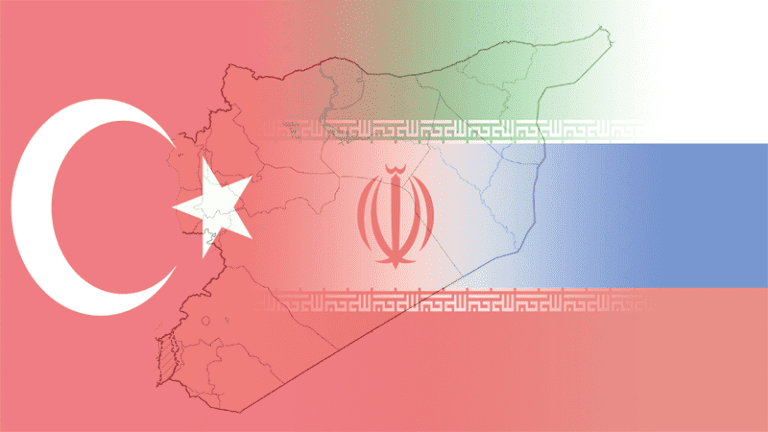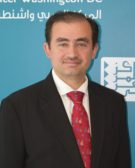
The late diplomat, politician, and publisher of the influential Lebanese daily An-Nahar, Ghassan Tueni, characterized the 15-year Lebanese civil war as “a war of others” on Lebanon’s soil. This has unfortunately become an apt description of the Syrian quagmire in the past few weeks. Israel seems to have entered an undeclared war with Iran in Syria, while the United States struck pro-Syrian regime targets in a clear challenge to the Russian forces protecting the regime. Turkey is in the middle of a military operation in northern Syria against the Syrian version of the Kurdistan Workers’ Party. In fact, what is left of the much-vaunted sovereign Syria that Bashar al-Assad’s regime extols appears to be an orphan seat at the United Nations, a failed state that does not control its entire territory, while the rest is under the control of Russia, the United States, Turkey, and the so-called Islamic State (IS).
The sole notable achievement from Sochi was the announcement of the creation of a constitutional commission under UN auspices.
Today, half the Syrian population is either internally displaced or dwells in neighboring countries as refugees. An estimated 88 percent of households in the south of Syria suffer from extreme poverty, lack basic services, and remain exposed to daily attacks. Civilians in other parts of the country also suffer from attacks by the United States against IS and al-Qaeda-affiliated factions, by Russia against opposition-held areas in Idlib and Eastern Ghouta, and by Turkey, which is attacking the Kurdish People’s Protection Units (YPG) in Afrin. Indeed, the new political and humanitarian landscape is hard to read, interpret, or understand. What began in 2011 as peaceful demonstrations for basic political change from authoritarian rule has become a battleground of foreign wars that have affected, and continue to affect, thousands of innocent victims every month.
The Russian Failure at Sochi
As many analysts and observers of Syrian developments had expected, the conference hosted by Russia at Sochi at the end of January was an utter failure, despite Russia’s denials. Russian President Vladimir Putin immediately fired Deputy Foreign Minister Gennady Gatilov who was overseeing the Syrian portfolio and organized the conference. Many reasons led to the failure, such as the lack of preparation, the wide gap between the positions of the participants, and the absence of a regional and international environment that could have helped de-escalate tensions. The United States declined to attend while the United Nations Special Envoy for Syria Staffan de Mistura attended only because of Russian pressure.
Russia hopes to confine US forces in Syria to the area surrounding Raqqa in the east.
The sole notable achievement from the conference was the announcement of the creation of a constitutional commission under UN auspices in the person of de Mistura according to stipulations in UNSC resolution 2254 of 2012. The composition of the commission will include government, opposition, and civil society representatives, Syrian constitutional experts, independents, and leaders of tribes and women’s organizations, all while ensuring an equitable ethnic and religious representation. At the same time, the conference appeared to be more of a Russian parade meant to show Moscow’s dominant role in finding a resolution to the Syrian crisis, despite Russia’s full knowledge that a solution does not begin in Sochi but in real pressure on the Syrian regime to allow for a political transition.
In response to its failure in Sochi, Russia resorted to an unprecedented escalation against civilian targets in Idlib and Eastern Ghouta near Damascus. There are reports of the use of chlorine gas in Saraqeb, where hundreds of civilians were killed, which led the United Nations High Commissioner for Human Rights, Zeid Ra’ad Al Hussein, to accuse Russia of committing war crimes.
The goal of Russia’s military escalation was to send a clear message to the Syrian opposition factions that refused to participate in the Sochi conference that it, Russia, possesses the key to a resolution in Syria. Russia had expected the opposition to accede to its conditions for the purported resolution, mainly to give up on the Geneva process of 2012—which has since then been the basis for the opposition’s position on a political solution. What Russia also likely hoped to achieve was to confine US forces in the area surrounding Raqqa in the east and to prevent the advance of US-supported YPG forces toward Deir Ezzor or other small and scattered areas where the Islamic State still maintains control. It is noteworthy that a brigade of IS fighters was able to cross into Idlib from regime-controlled areas, only to be arrested by the Free Syrian Army.
In sum, Russia’s main objective is to militarily defeat the Syrian opposition. All negotiation scenarios in Astana, Kazakhstan aimed simply to lessen international pressure. Moscow is busy employing its Security Council presence to prevent the creation of an international body to investigate chemical attacks in Syria after the term expires of the joint UN-Organization for the Prohibition of Chemical Weapons mission. Russia also exercised its veto power to prevent the condemnation of the Syrian regime, which the United Nations accused of direct responsibility for the use of such weapons in Khan Sheikhoun in April 2017.
The Confused American Position
The American strike on pro-Syrian government militias and Russian fighters does not represent a radical change in American policy in Syria.
There is obvious ambiguity in the current American position. While the White House refrained from criticizing Russia’s military escalation, the US Department of State issued a short statement expressing concern over civilian deaths without alluding to Russia’s role in the attacks. Secretary of State Rex Tillerson had announced a new position on Syria last January at Stanford University, in which he explicated his vision for the country: limiting Iran’s influence, defeating IS, preventing the use of chemical weapons, repatriating Syrian refugees, and ensuring a political transition without Assad.
But what may be forcing America’s hand is Russia’s expansion of its areas of control at the expense of all opposition and other forces, such as those of the Kurdish-dominated Syrian Democratic Forces around Raqqa and Deir Ezzor. Russia and the Syrian regime have signed a memorandum of understanding to cooperate on exploiting the oil and gas fields in Syria’s east, which are under the control of the Syrian Democratic Forces. The advance by regime militias in February 2018 toward these areas prompted American strikes that reportedly killed approximately 100 fighters, apparently including Russian military contractors. The United States quickly issued a statement that reiterated its position that US presence in the region only serves to help defeat remnants of IS, although it would defend itself and its allies against any threats. Whatever the impact of the strike, however, it did not signal a radical change in the American position on Syria.
Open Iran-Israel Confrontation
The destruction of an Iranian drone, the downing of an Israeli F-16 by Syrian anti-aircraft fire, and Israel’s retaliation may open the door to an Israeli-Iranian confrontation.
Iran’s involvement in Syria began since the beginning of the Syrian uprising in March 2011 and has since concentrated on supporting the Assad regime. At the outset, it sent political and military advisors who supervised the regime’s crackdown on activists and demonstrators. As the protest movement changed into an armed confrontation toward the beginning of 2012, Iran began sending Islamic Revolutionary Guard Corps contingents that manned roadblocks in cities, including Damascus. As the Syrian opposition gained momentum and controlled many cities like Aleppo, Iran sent in Shia militias such as Hezbollah and Iraqi formations. Later, it dispatched the Fatemiyoun Shia militias, for which it recruited Afghan refugees living on its territory.
Iran’s pivotal assistance resulted in the regime regaining control of cities and towns that had fallen into the opposition’s hands. By doing so, however, it created a deep sectarian schism in Syrian society while increasing the Assad regime’s dependence on the Islamic Republic’s military help. This, in turn, mortgaged Assad’s political position to Iran’s interests in the region and its different strategic choices.
With the downing of an Israeli F-16 by Syrian anti-aircraft fire following the destruction of an Iranian drone over the occupied Golan Heights, Syria could be said to have become an open conflict zone between Iran and Israel. Previously, Syria’s air defense system had failed in countering Israel’s air power; this time around, however, it has a different meaning with Iran taking up a more active role in facing the Israeli challenge. After the drone incident and the loss of the F-16, it is likely that Israel will have to do some serious thinking about future military operations against Syrian troops and Hezbollah fighters. On the other hand, Israel relies more on Russia than the United States in Syria. In fact, it could be speculated that Russia supports Israel’s hope of getting rid of the Iran-supported Shia militias in Syria and provides it with accurate intelligence.
Amid the Iran-Israel conflagration, Turkey is striving to expand its influence and control in Syria, especially after the changes in military fortunes on the ground and the realization that a political solution in Syria is more remote than anyone can imagine. Turkey’s advance against the YPG is clearly allowing Ankara to do what it wants in northern Syria after it succeeded in sidelining American objections to its military operations in Afrin, although no one knows how Turkey will handle these objections when it comes to advancing on Manbij to the east.
Whither the Political Solution?
The political solution for the Syrian conflict envisioned by the United States and others may have just become a mere mirage.
Today, Syria’s war appears to have entered an entirely new stage of escalation between regional powers at the expense of its people. United Nations Secretary General António Guterres described the latest military operations against civilians as among the most violent episodes of the Syrian conflict over the last seven years. Reports have stated that more than 1,000 victims were killed in aerial bombardment in January alone.
The political solution that the United States hopes will end the Syrian conflict has thus become a mirage. If the international community still believes that the Geneva process that produced Security Council Resolution 2254 is viable as the means to stop the violence and end the Syrian people’s suffering, then it must do something about the deteriorating military situation. Indeed, the political solution will have to start by ending the war of others that has been raging on Syria’s soil.

